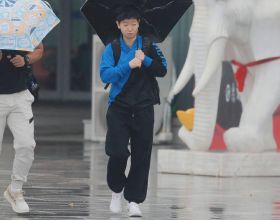正文翻譯
Thermoelectric heat transfer
熱電傳熱
A novel way to heat and cool things
一種新穎的供暖和製冷方式
A new approach to carrying heat around as an electric current
一種透過電流傳遞熱量的新方法
Refrigerators and air-conditioners are old and clunky technology, and represent a field ripe for disruption. They consume a lot of electricity. And they generally rely on chemicals called hydrofluorocarbons which, if they leak into the atmosphere, have a potent greenhouse-warming effect. Buildings’ central-heating systems, meanwhile, are often powered by methane in the form of natural gas, which releases carbon dioxide, another greenhouse gas, when it is burned, and also has a tendency to leak from the pipes that deliver it—which is unfortunate, because methane, too, is a greenhouse gas, and one much more potent than CO2.
電冰箱和空調都是老掉牙的技術,顛覆該領域的時機已成熟。它們消耗大量的電能,通常依靠氫氟碳化物,洩露到大氣中會造成巨大的溫室效應。建築物的中央供暖系統一般以天然氣形式的甲烷為動力源,燃燒時釋放出另一種溫室氣體二氧化碳,而且輸送管道容易發生洩漏,不幸的是甲烷也是一種溫室氣體,造成的溫室效應遠比二氧化碳更強。
One potential way of getting around all this might be to exploit what is known as the thermoelectric effect, a means of carrying heat from place to place as an electric current. Thermoelectric circuits can be used either to cool things down, or to heat them up. And a firm called Phononic, based in Durham, North Carolina, has developed a chip which does just that.
解決這類難題的一種潛在方法是利用熱電效應,透過電流傳遞熱量,熱電迴路可被用於冷卻或加熱物體。位於美國北卡萊羅納州達勒姆市的Phononic公司為此開發出一種晶片。
The thermoelectric effect was discovered in 1834 by Jean Charles Peltier, a French physicist. It happens in an electrical circuit that includes two materials of different conductivity. A flow of electrons from the more conductive to the less conductive causes cooling. A flow in the other direction causes heating.
1834年,法國物理學家簡·查理斯·帕爾貼發現了熱電效應。它產生於導電性不同的兩種導體組成的迴路中,電子從高導電材料流向低導電材料出現降溫,反向流動出現升溫。
The reason for this is that electrons are able to vibrate more freely when pushed into a conductive material. They thereby transfer energy to their surroundings, warming them. When shunted into a less conductive one, electrons’ vibrations are constrained, and they absorb energy from their surroundings, cooling those surroundings down. An array of thermoelectric circuits built with all the high-conductivity materials facing in one direction and all the low conductivity ones in the other can thus move heat in either direction, by switching the polarity of the current. For reasons buried in the mathematics of quantum physics, the heat thus flowing does so in discrete packages, called phonons. Hence the name of the firm.
原因是電子進入導電材料能夠更加自由的振動,將能量傳遞給周圍出現升溫。電子流向低導電材料後振動受到限制,吸收周圍的能量出現降溫。在製造的熱電迴路陣列中,所有的高導電材料朝一個方向,所有的低導電材料朝另一個方向,透過轉換電流的極性可以向任意方向傳遞熱量。由於原因隱藏在量子物理學的運算中,所以熱量是以“聲子”這種離散包的形式傳遞的,Phononic公司由此得名。
The thermoelectric effect works best when the conductors involved are actually semiconductors, with bismuth and tin being common choices. Fancy cameras contain simple cooling chips which use these, as do some scientific instruments. But Phononic’s boss, Tony Atti, thinks that is small beer. Using the good offices of Fabrinet, a chipmaker in Thailand, he has started making more sophisticated versions at high volume, using the set of tools and techniques normally employed to etch information-processing circuits onto wafers made of silicon. In this case, though, the wafers are made of bismuth.
熱電效應最顯著的是半導體,常用鉍和錫來製造。高檔相機配備的簡單製冷晶片就是採用這些材料,某些科學儀器也是如此。但Phononic公司總裁託尼·阿提認為這不算什麼,在泰國晶片製造商Fabrinet公司的幫助下,他採用在矽晶圓上蝕刻資訊處理電路的工具和技術,開始批次製造更尖端的晶片,但使用的是鉍晶圓。
The results are, admittedly, still a long way from something that could heat or cool a building. But they are already finding lucrative employment in applications where space is at a premium. At the moment, the fastest-growing market is cooling the infrared lasers used to fire information-encoding photons through fibre-optic cables, for the long-distance transmission of data. They are also being used, though, in the 5g mobile-phone base stations now starting to blanket street corners, to keep the batteries of electric vehicles at optimal operating temperatures, and as components of the optical-frequency radar-like systems known as lidar, that help guide autonomous vehicles.
不可否認,現有成果距離為建築物供暖或製冷還有很長的路要走,但他們正在尋找利潤豐厚而空間有限的用途。目前增長最快的市場是為紅外鐳射器進行冷卻,它被用於透過光纖電纜傳送資訊加密光子,實現遠端資料傳輸。這些晶片也被用於開始覆蓋大街小巷的5g手機基站,以及使電動汽車的蓄電池維持最佳工作溫度,還可作為鐳射雷達的零件,它類似於光頻雷達裝置,幫助導航無人駕駛汽車。
The crucial question from Mr Atti’s point of view is whether semiconductor-based thermoelectronics can break out of these niches and become more mainstream, in the way that semiconductor-based electronics and lighting have done. In particular, he would like to incorporate heat-pumping chips into buildings, to provide them with integral thermoregulation.
在阿提先生看來,關鍵問題是基於半導體的熱電產品能否突破小眾市場,就像基於半導體的電子和照明產品一樣成為主流。值得一提的是,他希望在建築物中安裝熱泵晶片,提供整體式溫度調節。
In their current form, thermoelectric chips are unlikely to replace conventional air conditioning and central heating because they cannot move heat over the distances required to pump it in and out of a building in bulk. But they could nonetheless be used as regulators. Instead of turning a big air-conditioning system on or off, to lower or raise the temperature by the small amounts required to maintain comfort, with all the cost that entails, thermoelectric chips might tweak matters by moving heat around locally.
現階段的熱電晶片不太可能替代常規空調和中央供暖系統,因為建築物大規模的熱量輸入和輸出需要一定距離,熱電晶片無法遠距離傳遞熱量,但可以把它作為調溫器。為了小幅度升高和降低溫度來保持舒適性,而不是開啟或關閉大型空調系統,考慮到所有的成本,熱電晶片可以透過區域性傳遞熱量來微調溫度。
Phononic has already run trials of such local-temperature-tweaking chips in Singapore, in partnership with Temasek, that country’s state-run investment fund. In 2019 sp Group, Singapore’s utility company, installed eight of the firm’s heat pumps, which comprise an array of chips pointed down at people, pumping heat out of the air above them, on the boardwalk on Clarke Quay in the city. Phononic claims the devices lowered the temperature in their vicinity by up to 10°C and, as a bonus, consequently reduced humidity by 15%. If that can be scaled up, it would certainly be a cool result.
Phononic公司已與新加坡的國有投資基金“淡馬錫”展開合作,在該國試驗了這種區域性溫度微調晶片。2019年,新加坡公共事業公司SP集團在克拉碼頭的木板人行道上安裝了八臺該公司的熱泵,它們由大量的晶片構成,居高臨下朝向行人,從他們頭頂吸走空氣中的熱量。Phononic公司聲稱,這些裝置能使周圍的溫度下降10°C,由此帶來的好處是溼度減少15%。如果可以擴大規模,必然帶來可喜的結果。


















